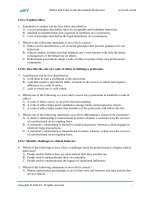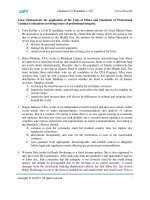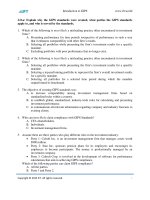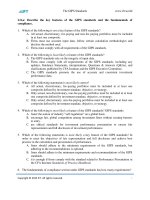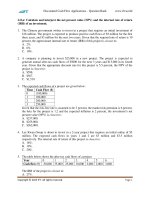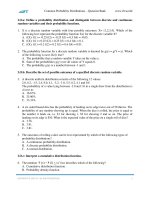CFA 2018 quest bank r10 common probability distributions q bank
Bạn đang xem bản rút gọn của tài liệu. Xem và tải ngay bản đầy đủ của tài liệu tại đây (511.73 KB, 16 trang )
Common Probability Distributions – Question Bank
www.ift.world
LO.a: Define a probability distribution and distinguish between discrete and continuous
random variables and their probability functions.
1. X is a discrete random variable with four possible outcomes: X= {1,2,3,4}. Which of the
following best represent the probability function f(x) for the discrete variable X?
A. f(X): f(1) = -0.25 f(2) = -0.25 f(3) = 0.5 f(4) = -0.05.
B. f(X): f(1) = 0.25 f(2) = 0.25 f(3) = 0.4 f(4) = 0.1.
C. f(X): f(1) = 0.2 f(2) = 0.2 f(3) = 0.6 f(4) = 0.01.
2. The probability function for a discrete random variable is denoted by g(y) = g(Y = y). Which
of the following is most likely true?
A. The probability that a random variable Y takes on the value y.
B. Sum of the probabilities g(y) over all values of Y equals 0.
C. The probability g(y) is a number between -1 and 1.
LO.b: Describe the set of possible outcomes of a specified discrete random variable.
3. A discrete uniform distribution consists of the following 12 values:
2.0, 6.2, -1.5, 2.4, 9.0, 4.1, -3.2, -1.0, 5.5, 8.2, 4.1 and 0.8
The probability of a value lying between -3.0 and 1.0 in a single draw from the distribution is
closest to:
A. 16.67%.
B. 25.00%.
C. 33.33%.
4. A six sided biased dice has the probability of landing on its edge twice out of 50 throws. The
probability of any number showing up is equal. When the dice is rolled, the prize is equal to
the number it lands on, i.e. $1 for showing 1, $2 for showing 2 and so on. The prize of
landing on its edge is $10. What is the expected value of the prize on a single roll of dice?
A. 3.76.
B. 3.91.
C. 3.81.
5. The outcomes of rolling a dice can be best represented by which of the following types of
probability distributions?
A. A continuous probability distribution.
B. A discrete probability distribution.
C. A normal distribution.
LO.c: Interpret a cumulative distribution function.
6. The notation „F (x) = P (X < x)‟ best describes which of the following?
A. Cumulative distribution function.
B. Probability density function.
COPYRIGHT © 2015 IFT. ALL RIGHTS RESERVED.
1
Common Probability Distributions – Question Bank
www.ift.world
C. Probability function.
LO.d: Calculate and interpret probabilities for a random variable, given its cumulative
distribution function.
7. Discrete uniform probability distribution of net profits for a currency option on EURO (€) is
as follows:
Net Profit (€)
Probability
Net profit of 0
0.25
Net profit of 2 or less
0.50
Net profit of 4 or less
0.75
Net profit of 6 or less
1.00
The probability of a net profit greater than €2 and less than or equal to €6 is closest to:
A. 1.00.
B. 0.75.
C. 0.50.
8. A box contains 10 labeled pieces of paper. Each piece of paper has one integer ranging
between 1 and 10 written on it, and the numbers are not repeated. If you draw a piece of
paper at random, then the probability that the number is greater than 3 and less than or equal
to 7 is closest to:
A. 0.40.
B. 0.50.
C. 0.60.
LO.e: Define a discrete uniform random variable, a Bernoulli random variable, and a
binomial random variable.
9. Which of the following best describes the binomial distribution? The binomial distribution:
A. has an infinite number of specified outcomes.
B. has an infinite number of unspecified outcomes.
C. is based on the Bernoulli random variable.
10. Which of the following is least likely an assumption of the binomial distribution?
A. The probability, p, of success is constant for all trials.
B. The trials are independent.
C. The probability of failure is the reciprocal of the probability of success.
LO.f: Calculate and interpret probabilities given the discrete uniform and the binomial
distribution functions.
11. Karachi Footy Club, an emerging football team, had a tough last season with a win to loss
record of 1 to 5. In order to contest and increase its chances of winning, the team signed 2
new players and it is estimated that the chances of winning a game in the next season are
COPYRIGHT © 2015 IFT. ALL RIGHTS RESERVED.
2
Common Probability Distributions – Question Bank
www.ift.world
60%. Assuming that winning a single game is independent of other games, the probability
that the team will win 2 out of next 5 games is closest to:
A. 0.2304.
B. 0.3456.
C. 0.5184.
12. You toss a coin 14 times. The probability of getting exactly 6 tails is:
A. 0.016.
B. 0.183.
C. 0.428
LO.g: Construct a binomial tree to describe stock price movement.
13. An investor charts the movement of a stock‟s price over the next three years as follows:
T=0
S0 = 45
T=1
Su = 49.5
Sd = 40.5
T=2
Suu = 54.45
Sud.du = 44.55
Sdd = 36.45
The initial price of the stock is $45. The probability of the price increasing at any given point
is 55% and that of the price decreasing is 45%. The probability, using the binomial model,
that the stock‟s price would be $36.45 two years later is closest to:
A. 20.25%.
B. 24.75%.
C. 30.25%.
14. Suppose National Refinery Limited‟s (NRL) expected price over the next two periods is as
shown below.
Time = 0
NRL0 = 100
Time = 1
NRLu = 110
NRLd = 90
Time = 2
NRLuu = 121
NRLud,du = 99
NRLdd = 81
NRL‟s current price is $100. The probability of an up move in any given period is 65% and
the probability of a down move in any given period is 35%. Using the binomial model, the
probability that the NRL‟s price will be $99 at the end of two periods is closest to:
A. 42.25%.
B. 22.75%.
C. 45.50%.
15. Assume that a stock‟s price over the next two periods is as shown below:
COPYRIGHT © 2015 IFT. ALL RIGHTS RESERVED.
3
Common Probability Distributions – Question Bank
Time = 0
S0 = 60
Time = 1
Su = 69
Sd = 51
www.ift.world
Time = 2
S uu = 79.35
S ud,du = 58.65
S dd = 43.35
The initial value of the stock is $60. The probability of an up move in any given period is
60% and the probability of a down move in any given period is 40%. Using the binomial
model, the probability that the stock‟s price will be $58.65 at the end of two periods is closest
to:
A. 24%.
B. 32%.
C. 48%.
16. A stock‟s price over the next two periods is as shown below.
Time = 0
S0 = 100
Time = 1
Su = 105
Sd = 95
Time = 2
Suu = 110
Sud,du = 102
Sdd = 90
The initial value of the stock is 100. From historical data, it has been observed that the
probability of an up move in any given period is 30% and the probability of a down move in
any given period is 70%. Using the above data, the probability that the stock‟s price will be
equal to 102 at the end of period 2 is closest to:
A. 21%.
B. 49%.
C. 42%.
17. Using the same data as in the previous question, the expected prices of the stock at the end of
period 1 and period 2 are closest to:
A.
B.
C.
Time 1
98
102
98
Time 2
96.84
83.42
84.84
18. A bank has issued loans to 60 customers. Based on past experience, the bank expects 10% of
the customers to default. Which of the following is most likely the expected number of
defaults and the standard deviation of the number of defaults?
COPYRIGHT © 2015 IFT. ALL RIGHTS RESERVED.
4
Common Probability Distributions – Question Bank
A.
B.
C.
Expected
number of
defaults
5.40
6
6
Standard
deviation
www.ift.world
.
6
5.40
2.32
LO.h: Calculate and interpret tracking error.
19. Alex, a fund manager at Morgan Investment Bank manages Anil‟s portfolio. At the
beginning of the year, the portfolio had a value of $50,000 and at the end it was $45,000.
Alex‟s performance is measured against an index which declined by 8% in that year due to
below average economic conditions. The tracking error of this portfolio is closest to:
A. 2%.
B. -2%.
C. -18%.
LO.i: Define the continuous uniform distribution and calculate and interpret probabilities,
given a continuous uniform distribution.
20. At a restaurant, the service time for a single order is uniformly distributed between 10 to 18
minutes. If a customer places an order at 5:30 PM, what is the probability that the order will
be served after 5:45 PM?
A. 0.375.
B. 0.833.
C. 0.660.
LO.j: Explain the key properties of the normal distribution.
21. Which of the following statements about a normal distribution is most accurate? A normal
distribution:
A. has an excess kurtosis of 3.
B. is partially described by two parameters.
C. can be the linear combination of two or more normal random variables.
22. Which of the following is the most likely characteristic of the normal probability distribution?
The normal probability distribution:
A. has an excess kurtosis of 3.0.
B. has a mode higher than mean and median.
C. is more suitable as a model for returns than for asset prices.
23. Which of the following is least likely a characteristic of the normal distribution?
A. Skewness = 0.
B. Kurtosis = 3.
COPYRIGHT © 2015 IFT. ALL RIGHTS RESERVED.
5
Common Probability Distributions – Question Bank
www.ift.world
C. Mean > Mode.
24. The normal density with µ = 0 and σ = 1 is called a:
A. standard normal distribution.
B. lognormal distribution.
C. binomial distribution.
LO.k: Distinguish between a univariate and a multivariate distribution, and explain the
role of correlation in the multivariate normal distribution.
25. A multivariate distribution for the returns on y stocks is most likely defined by which of the
following parameters?
A. mean returns on (y-1) securities.
B. variances of returns of (y-1) securities.
(
)
C.
pairwise return correlations.
26. Which of the following is an example of a multivariate distribution?
A. Distribution of returns on each asset in a group of assets.
B. Distribution of returns on the assets as a group.
C. Distribution considering the means and variances of the assets in the group.
LO.l: Determine the probability that a normally distributed random variable lies inside a
given interval.
27. In a normal distribution, approximately what percent of all observations fall in the interval μ
± σ?
A. 68 percent.
B. 50 percent.
C. 99 percent.
28. In a normal distribution, approximately 99 percent of all observations fall within which of the
following intervals?
A. μ ± 2σ.
B. μ ± 3σ.
C. μ ± σ.
29. Two students, Miley and Mariah, make the following statements:
Miley: Approximately 5% of the observations lie outside the range of µ ± 2σ.
Mariah: Approximately 68% of the observations lie in the interval µ ± σ.
Which of the above statements is most likely correct?
A. Only Miley‟s statement.
B. Only Mariah‟s statement.
C. Both Miley and Mariah‟s statements.
COPYRIGHT © 2015 IFT. ALL RIGHTS RESERVED.
6
Common Probability Distributions – Question Bank
www.ift.world
LO.m: Define the standard normal distribution, explain how to standardize a random
variable, and calculate and interpret probabilities using the standard normal distribution.
30. Given that X follows a normal distribution with a mean of 4.5 and standard deviation of 1.5,
the standardized value corresponding to X=8.9 would be closest to:
A. 1.64.
B. 2.93.
C. 5.93.
31. Consider a variable that is normally distributed with a mean of 10 and a variance of 16. To
find the probability of observing a value of -1 or less, the calculated Z value is closest to :
A. -2.7500.
B. -0.6875.
C. 0.0035.
32. In order to standardize a random variable X, the steps that most accurately describe the
process are :
A. subtract the mean of X from X, and then divide that result by the standard deviation of X.
B. subtract the mean of X from X, and then divide that result by the standard deviation of
the standard normal distribution.
C. divide X by the difference between the standard deviation of X and the standard deviation
of the standard normal distribution.
33. A portfolio has a mean return of 15% and a standard deviation of return of 20% per year.
Given the following information, the probability that the portfolio return will be below 18%
is closest to:
P (Z < 0.15) = 0.5596, P (Z > 0.15) = 0.4404, P (Z < 0.18) = 0.5714, P (Z > 0.18) = 0.4286.
A. 0.5596.
B. 0.4404.
C. 0.5714.
34. A portfolio has a mean return of 15% and a standard deviation of return of 20% per year.
Given the following information, the probability that the portfolio return will be between
16% and 20% is closest to:
P (Z < 0.16) = 0.5636, P (Z < 0.20) = 0.5793, P (Z < 0.05) = 0.5199, P (Z < 0.25) = 0.5987
A. 0.0157.
B. 0.0788.
C. 0.1186.
LO.n: Define shortfall risk, calculate the safety-first ratio, and select an optimal portfolio
using Roy’s safety-first criterion.
35. Information about three possible asset allocations is given below:
COPYRIGHT © 2015 IFT. ALL RIGHTS RESERVED.
7
Common Probability Distributions – Question Bank
Allocation
I
II
III
Expected Annual Return
8%
19%
24%
www.ift.world
Standard deviation of return
3%
11%
16%
Assuming a minimum acceptable return of 6%, based on Roy‟s safety-first criterion, the most
appropriate allocation is:
A. I.
B. II.
C. III.
36. The table below shows data on three portfolios:
Portfolio
1
2
3
Expected Return
15%
19%
22%
Standard Deviation
33%
40%
48%
Assuming the minimum acceptable rate of return is 6%, under Roy‟s safety-first criterion,
which of the following portfolios is the most appropriate choice?
A. Portfolio 1.
B. Portfolio 2.
C. Portfolio 3.
37. An investor has a portfolio of $100,000. His investment objective is long term growth but he
will need $2,000 for his medical insurance and another $2,000 for his rent expenses by the
end of the year. The investor is considering investing in one of these three available
portfolios:
Portfolio Expected Return
Standard Deviation
A
5%
10%
B
8%
13%
C
14%
22%
Using Roy‟s safety-first criterion ratio, which one of these portfolios will minimize the
probability of the investor‟s portfolio falling below $100,000?
A. Portfolio A.
B. Portfolio B.
C. Portfolio C.
38. Which of the following risks is evaluated by the safety-first rules?
A. Downside risk.
B. Default risk.
C. Upside risk.
COPYRIGHT © 2015 IFT. ALL RIGHTS RESERVED.
8
Common Probability Distributions – Question Bank
www.ift.world
39. An investor has a portfolio worth $750,000. At the end of the year, the investor wishes to
liquidate $33,750, without using the initial capital. According to the safety-first criterion,
which of the following alternatives is the best approach?
Alternative
Expected annual return
Standard deviation of return
A.
30%
32%
B.
15%
12%
C.
20%
25%
A. Allocation A.
B. Allocation B.
C. Allocation C.
LO.o: Explain the relationship between normal and lognormal distributions and why the
lognormal distribution is used to model asset prices.
40. Which of the following statements regarding the distributions used for asset pricing is most
accurate?
A. Normal distribution returns will not let returns fall below zero in the case of asset pricing.
B. Lognormal distribution returns will never fall in value below zero.
C. Binomial distribution will allow the asset‟s value to stay positive and realistic as per the
current market.
LO.p: Distinguish between discretely and continuously compounded rates of return, and
calculate and interpret a continuously compounded rate of return, given a specific holding
period return.
41. The continuously compounded daily returns for ICI shares are normally distributed. The
probability distribution for ICI share prices most likely follow a:
A. Normal distribution.
B. Lognormal distribution.
C. Neither of the above.
42. The price per share of RBook is $45. Exactly, one year later, the stock is trading at $55. The
continuously compounded return over the one year period is closest to:
A. 18.18%.
B. 20.06%.
C. 22.22%.
LO.q: Explain Monte Carlo simulation and describe its applications and limitations.
43. Which of the following models can be efficiently used to value a call option?
A. Black-Scholes-Merton model.
COPYRIGHT © 2015 IFT. ALL RIGHTS RESERVED.
9
Common Probability Distributions – Question Bank
www.ift.world
B. Monte Carlo simulation.
C. Historical simulation.
44. Which of the following is most likely a weakness of the Monte Carlo simulation?
A. It provides only estimates, and not exact results.
B. It is based only on past data, and is not fully reflective of all risks.
C. It is possible only through the use of supercomputers.
LO.r: Compare Monte Carlo simulation and historical simulation.
45. Which of the following statements about simulation models is least accurate?
A. Historical simulation models use the historical data to analyze “what-if” scenarios.
B. Historical simulation analyzes risks from the events that occurred during the sample
period.
C. Monte Carlo simulation provides only statistical estimates, and not exact results.
46. Which of the following methods addresses the „what-if‟ question?
A. Historical simulation.
B. Monte Carlo simulation.
C. Value at risk approach.
COPYRIGHT © 2015 IFT. ALL RIGHTS RESERVED.
10
Common Probability Distributions – Question Bank
www.ift.world
Solutions
1. B is correct because the sum of f(x) over all values of X must equal 1 and 0 <= p(x) <=1.
2. A is correct. The sum of the probabilities g(y) over all values of Y equals 1. The probability
g(y) is a number between 0 and 1.
3. B is correct. First order the values from smallest to largest. Then note that three of the twelve
values are between -3.0 and 1.0. Thus, the probability of a draw from the distribution being
between -3.0 and 1.0 is 3/12 = 0.25.
4. A is correct. The probability of the dice landing on its edge is 2/50 = 0.04. Since the dice is
biased, the probability of showing up any number won‟t be 1/6. It has been stated that the
probability of showing any number is equal, i.e.
= 0.16. The distribution is as follows:
Outcome
Probabilities
Prizes
Expected Value
Edge
0.04
$10
0.4
1
0.16
$1
0.16
2
0.16
$2
0.32
3
0.16
$3
0.48
4
0.16
$4
0.64
5
0.16
$5
0.80
6
0.16
$6
0.96
3.76
5. B is correct. When a dice is rolled, since there are a finite number of outcomes, it is an
example of a discrete probability distribution.
6. A is correct. The cumulative distribution function gives the probability that a random
variable X is less than or equal to a particular value x, P (X < x).
7. C is correct. P(X ≤ 6) = 1.0 and P(X ≤ 2) = 0.50. Therefore, P (2 ≤ X ≤ 6) = 1.0 – 0.50 =
0.50.
8. A is correct. The probability of each piece of paper being drawn will be 1/10 = 0.10.
P (3 < x < 7) = P (x < 7) – P (x < 3)
P (3 < x < 7) = P (x< 1, 2, 3, 4, 5, 6, 7) – P (x < 1, 2, 3)
P (3 < x < 7) = (0.1 * 7) – (0.1 * 3)
P (3 < x < 7) = 0.40.
9. C is correct. A binomial distribution is based on the Bernoulli random variable.
10. C is correct. Probability of failure = 1 – probability of success. Hence, it is not the reciprocal.
COPYRIGHT © 2015 IFT. ALL RIGHTS RESERVED.
11
Common Probability Distributions – Question Bank
www.ift.world
In addition, this statement is not an assumption of the binomial distribution. The binomial
distributions make only two assumptions, which are the first two choices listed in this
example.
11. A is correct. Using Binomial to calculate the probability of 2 wins out of 5 games:
P(x) = P(X = x) = [number of ways to choose x from n] × px × (1 - p)n-x
P(Win) = 0.6
P(Lose) = 0.4
P(2 out 5) = 5C2 x 0.62 x (1-0.6)3 = 0.2304
12. B is correct.
( ) (
)
(
) (
)
.
13. A is correct. Only two consecutive downward movements would lead to the price being
$36.45 two years later. The probability of two consecutive downward movements is 0.45 *
0.45 = 0.2025 = 20.25%.
14. C is correct. The probability of an up move followed by a down move is
. The probability of a down move followed by an up move is
also =
0.2275. Both of these sequences result in an end value of $99. Therefore, the probability of
an end value of $99 is
(0.2275 + 0.2275) = 45.5%.
15. C is correct. The probability of an up move followed by a down move is 0.60 times 0.40
equals 0.24. The probability of a down move followed by an up move is 0.40 times 0.60 also
equals 0.24. Both of these sequences result in an end value of $58.65. Therefore, the
probability of an end value of $58.65 is 48%.
16. C is correct. There are four possibilities that stock price can take. It can move up-up, updown, down-up and down-down. In order to reach 102, a stock‟s price can either go up first
and then down or the other way. Probability for the stock going up first and then down is
. This probability will be the same for the stock going down first and then
up which is,
. Therefore, the probability of the stock‟s price reaching 102 is
42% (
)
17. A is correct.
COPYRIGHT © 2015 IFT. ALL RIGHTS RESERVED.
12
Common Probability Distributions – Question Bank
Time 1
www.ift.world
Time 2
0.3
0.3 x 0.3 x 110 = 9.9
0.3 x 105 =31.5
0.3
0.7
0.7
0.3 x 0.7 x 102 = 21.42
0.3
0.7 x 0.3 x 102 = 21.42
0.7
0.7 x 0.7 x 90 = 44.1
0.7 x 95 = 66.5
31.5 + 66.5 = 98
9.9+21.42+21.42+44.1=96.84
18. C is correct.
√
(
)
√
.
19. B is correct. Tracking error is the portfolio total return less the benchmark total return. The
portfolio return is
(45000 - 50000)/50000 = -10%. Benchmark return is 8% and therefore the tracking error is 10% - (-8%) = -2%.
20. A is correct. In uniform distribution the probability can be found of a range only instead of a
point. The time is uniformly distributed from 10 to 18 minutes, i.e. 8 minutes. If a customer
places order at 5:30, the probability of being served after 5:45 leaves 3 minutes buffer for a
server as it takes from 10 to 18 minutes to serve. Therefore, the probability is 3/8 or 0.375.
21. C is correct. A normal distribution has an excess kurtosis of 0 (kurtosis of 3), is completely
described by two parameters (mean and variance) and a liner combination of two or more
normal random variables is also normally distributed.
22. C is correct. A normal distribution is more suitable as a model for returns than for asset
prices.
23. C is correct. The mean, median, and mode for a normal distribution are equal. It has a
skewness of 0 and a kurtosis of 3.
24. A is correct. The normal density with µ = 0 and σ = 1 is called a standard normal distribution
or unit normal distribution.
COPYRIGHT © 2015 IFT. ALL RIGHTS RESERVED.
13
Common Probability Distributions – Question Bank
www.ift.world
25. C is correct. The three parameters that define a multivariate distribution for returns on y
stocks include mean returns on y securities, variances of returns on y securities, and
(
)
pairwise return correlations.
26. B is correct. C is incorrect because it did not include correlations between the assets. A is
incorrect because it is not a distribution of a single asset (or a random variable), but as a
group.
27. A is correct. Approximately 50 percent of all observations fall in the interval μ ± (2/3)σ.
28. B is correct. Approximately 68 percent of all observations fall in the interval μ ± σ.
Approximately 95 percent of all observations fall in the interval μ ± 2σ.
29. C is correct. Miley and Mariah are both correct.
30. B is correct. If X follows a normal distribution with parameters μ and σ, X can be
standardized using the formula:
Z = (X- μ) † σ
= (8.9 – 4.5) ÷1.5
= 2.93
31. A is correct. First, standardize the value of interest, –1, for the given normal distribution:
Z = (X – μ)/σ = (–1 – 10)/4 = –2.75.
32. A is correct. There are two steps in standardizing a random variable X: Subtract the mean of
X from X, and then divide that result by the standard deviation of X.
33. A is correct.
(
)
(
)
(
)
If the values from the table are not given, then using the cdf table for standard normal
variable, find the entry corresponding to 0.10 in the row and 0.05 in the column, which is
0.5596.
This implies the probability that the portfolio return will be less than 18% is 55.96 percent.
34. B is correct.
(
)
(
(
)
)
(
COPYRIGHT © 2015 IFT. ALL RIGHTS RESERVED.
)
(
)
14
Common Probability Distributions – Question Bank
www.ift.world
35. B is correct. Roy‟s safety-first ratio = [E(RP) – RL] / Standard deviation of P with the
optimal portfolio having the highest ratio. The safety-first ratios for the three allocations are:
Allocation
Safety-first ratio
I
0.67
II
1.18
III
1.125
36. C is correct. The portfolio with the highest SF-Ratio is preferred. The SF-Ratio is calculated
by subtracting the target return from the expected return and dividing by the standard
deviation.
Portfolio 1: 0.270
Portfolio 2: 0.325
Portfolio 3: 0.333.
37. C is correct. The investor requires a minimum return of
or 4 percent. Roy‟s safety-
first model uses the excess of each portfolio‟s expected return over the minimum return and
divides that excess by the standard deviation for that portfolio. The highest safety-first ratio
is associated with Portfolio 3: (14% – 4%)/22% = 0.45.
38. A is correct. The safety-first rules is an approach to evaluate the downside risk or shortfall
risk.
39. B is correct.
The formula for SF ratio is
[ (
)
]
Calculate the safety first ratios for each allocation:
Since allocation B has the highest ratio, it‟s the best one.
40. B is correct. Only lognormal distributions are used for asset pricing models because their
value is above zero, i.e. they always stay positive and asset pricing cannot be negative. The
normal distribution will allow prices to be negative.
COPYRIGHT © 2015 IFT. ALL RIGHTS RESERVED.
15
Common Probability Distributions – Question Bank
www.ift.world
41. B is correct. If the continuously compounded returns are normally distributed, then the future
stock price is log-normally distributed.
42. B is correct. Continuously compounded return = ln (1+ holding period return) = ln (55/45) =
0.2006 = 20.06%.
43. A is correct. BSM model takes into account the sensitivity of call values to changes in a stock
price and other variables which the others do not.
44. A is correct. Monte Carlo simulation only provides statistical estimates and not exact results.
45. A is correct. Historical simulation does not analyze what-if scenarios.
46. B is correct. The Monte Carlo simulation addresses the what-if question.
COPYRIGHT © 2015 IFT. ALL RIGHTS RESERVED.
16
